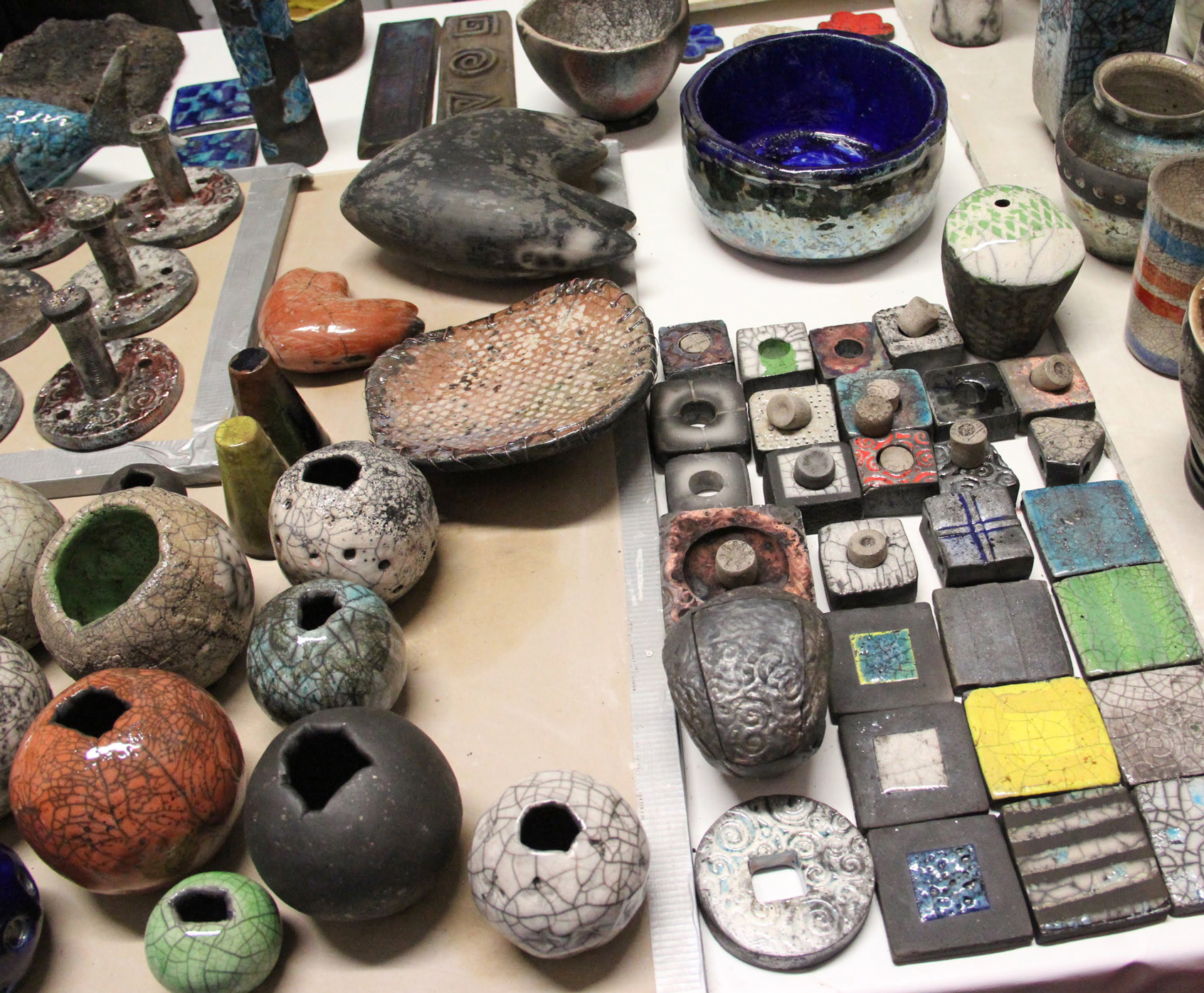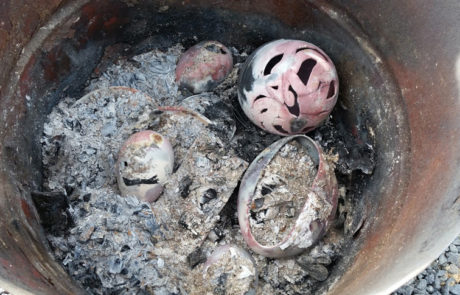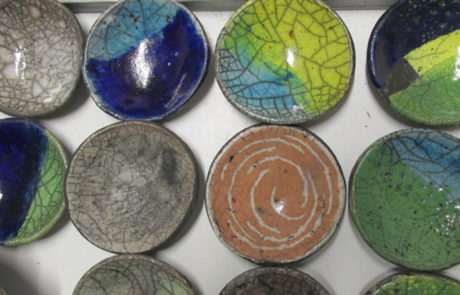
Earth – fire –water – air
August 17 – October 21, 2018
Sigurlína Osuala
Pottery is the oldest craft technique that is still practised today. During the Stone Age (7000 -3000 BC), stone vessels gave way to clay pots. Clay was sourced from nearby ground, formed, and fired over an open flame. It is almost magical that this substance yielded by the earth, which is taken for granted by many as something insignificant, can be moulded into shape and take on solid form by the touch of fire. Methods and techniques for shaping clay, glazing and firing it have developed and diversified, but the essentials remain the same. The range of the material and artists‘ approaches are infinite; but each person must learn to know the obstacles and limits of the clay, and seek out possibilities by bonding with the clay, and displaying patience, perseverance and respect for the material. Clay is a live substance which touches all human emotions: something which appears simple may be hard, bringing out sweat and tears, patience and diligence, as well as great joy, enjoyment and triumph.
The exhibition From Earth to Artefact presents hand-formed and turned clay pieces fired using the raku technique or other simple methods. They have been made by participants in a course held in the autumn of 2017 on the initiative of potters Steinunn Aldís Helgadóttir and Hrönn Waltersdóttir of Hveragerði and Ingibjörg Klemenzdóttir. The course was held at Ingibjörg‘s home/studio in Ölfus. They brought a Swedish potter and teacher, Anders Fredholm, to Iceland to teach the participants to build a wood-fired kiln for raku-firing, and other simple kilns. In addition to the three organisers, six more potters from around Iceland also took part: Bjarnheiður Jóhannsdóttir, Guðbjörg Björnsdóttir, Hólmfríður Arngrímsdóttir, Katrín Karlsdóttir, Ólöf Sæmundsdóttir and Þórdís Sigfúsdóttir. The clay works were either made during the course, or afterwards.
The story of raku firing goes back to the 16th century. Originating in Kyoto in Japan, it is one of the best-known methods for making the tea bowls used in Japanese tea ceremonies. Raku ware was appreciated by tea-masters for its rough-hewn “natural“ character.
Raku is a low-fire method, where the dry clay object is placed in the hot kiln and rapidly fired up to a temperature of 800-1000°C, then removed from the kiln and cooled. Japanese raku bowls were hand-formed earthenware vessels. The clay was coarse, and contained a high proportion of grog (fired, ground clay) so that vessel would tolerate the stress of firing and cooling.
The raku technique was brought from Japan to the West in 1911 by British potter Bernard Leach. His works and ideology had a profound influence on potters internationally. He wrote about the firing method and held courses and other events, spreading knowledge of raku around the western world, and it took on new forms. In the 1960s raku became very popular in the USA; potter Paul Soldner pioneered new methods of post raku firing. The raku method was essentially the same as in Japan, i.e. a dry clay object is placed in a hot kiln, heated rapidly to the firing temperature of the glaze, then removed and cooled in water or in the open air. In post raku firing the firing process continues: the object is moved directly from the kiln to a barrel filled with sawdust or other combustible material. In the barrel a process of reduction (low-oxygen firing) alters the texture and surface of the clay and glaze. A raku kiln may be gas- or wood-fired, built of heat-resistant stones or of kaolin fibre held together with chicken net. Raku ware may be either glazed or unglazed, and glazes include shiny white crackle-glaze, a smooth oily glaze, or dry copper glaze. When the object is placed in the sawdust, smoke forms, colouring the clay black and seeping into cracks in the glaze.
In the western world, unlike Japan, most clay vessels for raku-firing were made by turning, and works took on different forms. Paul Soldner often used turning as the basis for a work, removing it from the lathe and developing it further by other methods. Various artists started to use clay and raku technique as a medium for their creative work. One of these was Peter Voulkos.
About 40 years ago a new method in raku firing appeared, quite by chance: Naked Raku. The name derives from a layer of slip and crackle-glaze applied to the bisque-fired clay falling off towards the end of the firing process, leaving the bare surface exposed. The slip and crackle-glaze prevent the smoke reaching the surface except where cracks form in the slip, or where a design has been drawn in it.
A potter may wish to be left alone to work, in order to be able to concentrate and focus on the raku firing; others meet up together to fire their work, fostering a sociable atmosphere and a sense of anticipation and learning from each other. The four classical elements – earth, fire, water and air – are involved in the firing; and their variable contributions determine the outcome. The potter is part of the firing process; they are not in charge. The potter bonds with the earth, enjoys, and joyfully awaits the unexpected.
Let us end with Paul Soldner’s words:
“In the spirit of raku, there is the necessity to embrace the element of surprise. There can be no fear of losing what was once planned and there must be an urge to grow along with the discovery of the unknown. In the spirit of raku: make no demands, expect nothing, follow no absolute plan, be secure in change, learn to accept another solution and, finally, prefer to gamble on your own intuition. Raku offers us a deep understanding of those qualities in pottery which are of a more spiritual nature, of pots by men willing to create objects that have meaning as well as function.“
( Soldner, 1973 )
Sources:
Cooper, Emmanuel (2000), Ten Thousand Years of Pottery, 4th ed. p. 79, Philadelphia, University of Pennsylvania Press Byers, Ian (1990), The Complete Potter, Raku, London B.T. Batsford Ltd Lazo, Eduardo (2012), Naked Raku and Related Bare Clay Techniques, USA, The American Ceramic Society
About the artists:
Bjarnheiður Jóhannsdóttir
Bjarnheiður graduated from Akureyri High School in 1989, majoring in art. She then studied for two years at the Icelandic School of Arts and Crafts (precursor of the Iceland University of the Arts), and in 1994 she graduated with an MA from the Moholy-Nagy University of Art and Design in Hungary. Bjarnheiður has taken part in many group exhibitions over the years, and has held two solo shows at Stöðlakot in Reykjavík, the most recent in 1997. Bjarnheiður runs a ceramics studio at her home at Jörvi in Haukadalur, west Iceland.
Guðbjörg Björnsdóttir
Guðbjörg graduated in 1991 from the arts department of the Iceland University of Education, and in 2015 she completed a diploma in ceramics from the Reykjavík School of Visual Arts. In the summer of 2017 she was awarded an Erasmus grant for an internship at the Wagner & Apel porcelain factory in Germany. Guðbjörg has held two solo shows at Leifsbúð in Búðardalur in 2011 and 2016, and at present she has a work in an exhibition in Germany. Guðbjörg works as a special needs teacher at Lindaskóli in Kópavogur, and teaches art at the Reykjavík School of Visual Arts. She is a member of FÍMK, the Icelandic Association of Art Educators. Guðbjörg has a ceramics studio in Íshús, a former freezing-plant in Hafnarfjörður.
Hólmfríður Vídalín Arngrímsdóttir
Hólmfríður studied at the ceramics department of the Academy of Fine Arts in Aarhus, Denmark 2009-12. She has taken part in group exhibitions in Denmark, and in Reykjavík, Akureyri and Dalvík in Iceland. Her work was included in the exhibition Ceramics at the LÁ Art Museum in 2016, marking the 35th anniversary of the Association of Icelandic Ceramic Artists. She is a member of the Assoaciation and of SÍM, the Association of Icelandic Visual Artists. She lives in Ólafsfjörður, where she has her ceramics studio. She was also involved for a time in running the Kaolin gallery in Reykjavík.
Hrönn Waltersdóttir
Hrönn studied at the Hafnarfjörður Technical College 2009-11, majoring in art, design and crafts. In 2013 she completed a diploma in ceramics from the Reykjavík School of Visual Arts, and in 2014 she graduated from the University of Cumbria, UK, with a BA in contemporary applied arts. The following year she attended a course at the Reykjavík School of Visual Arts taught by Jens Pfotenhauer. Hrönn has held two solo shows at the Geothermal Park in Hveragerði, and participated in several group exhibitions in Iceland and the UK. Her work was included in the exhibition Ceramics at the LÁ Art Museum in 2016, marking the 35th anniversary of the Association of Icelandic Ceramic Artists. Hrönn runs a ceramics studio in Hveragerði.
Ingibjörg Klemenzdóttir
Ingibjörg studied at the Reykjavík School of Visual Arts 1993-95 and at the Kópavogur School of Art 1994-95. She commenced studies at the ceramics department of the Icelandic School of Arts and Crafts in 1996, was a guest student at the Kecskemét ceramics studio in Hungary in 1999, and completed her BA from the Iceland University of the Arts in 2000. Ingibjörg has been a participant in a group show in Spain, and in many in Iceland. Her work was included in the exhibition Ceramics at the LÁ Art Museum in 2016, marking the 35th anniversary of the Association of Icelandic Ceramic Artists. She is a member of the Association and of SÍM, the Association of Icelandic Visual Artists. Ingibjörg runs a ceramics studio at Hellugljúfur, Ölfus.
Katrín V. Karlsdóttir
Katrín graduated from the Iceland University of Education in 1988, and from the Iceland University of the Arts in 2001. She was a guest student at the Kecskemét ceramics studio in Hungary in 1999. She has taken part in a number of group shows in Iceland, and her work was included in the exhibitionCeramics at the LÁ Art Museum in 2016, marking the 35th anniversary of the Association of Icelandic Ceramic Artists. Katrín is a member of the Association and of SÍM, the Association of Icelandic Visual Artists. She is one of eight owners of the Kaolin ceramics gallery in Reykjavík and also runs her own studio, Kvalka Keramik Studio.
Ólöf Sæmundsdóttir
Ólöf attended various art courses on glass art, drawing, oil painting and metal design at the Hafnarfjörður Technical College during her time at the Breiðholt Comprehensive College, where she majored in art, graduating in 2007. She completed a diploma in ceramic from the Reykjavík School of Visual Arts in 2010, since then she has attended more courses in glasswork, ceramics and life drawing. She held four solo shows in 2004-08 and has taken part in group shows. Ólöf is one of seven artists who run the arts space Stígur in Reykjavík.
Steinunn Aldís Helgadóttir
Steinunn Aldís graduated from the ceramics department of Stockholm University and from the applied arts programme of Levande verkstad at Årstagårdens Folkhögskola in Stockholm, where she lived for many years. She has shown her work at Svarta katten in Stockholm, and in Iceland at Gullkisan at Laugavatn, Gróska in Garðabær and Handverk og Hönnun/Crafts and Design in Reykjavík. In 2015 Steinunn Aldís moved to Hveragerði, where she has a studio at Listhúsið Egilsstaðir together with the group Handverk og Hugvit undir Hamri.
Þórdís Sigfúsdóttir
Þórdís studied at the ceramics department of the Academy of Fine Arts in Aarhus, Denmark, 2010-13, and held a research fellowship there 2013-14. She has taken part in a number of group shows in Iceland and Denmark. Her work was included in the exhibition Ceramics at the LÁ Art Museum in 2016, marking the 35th anniversary of the Association of Icelandic Ceramic Artists. Þórdís runs her own ceramics studio/gallery at Dalbrekka 32 in Kópavogur.




